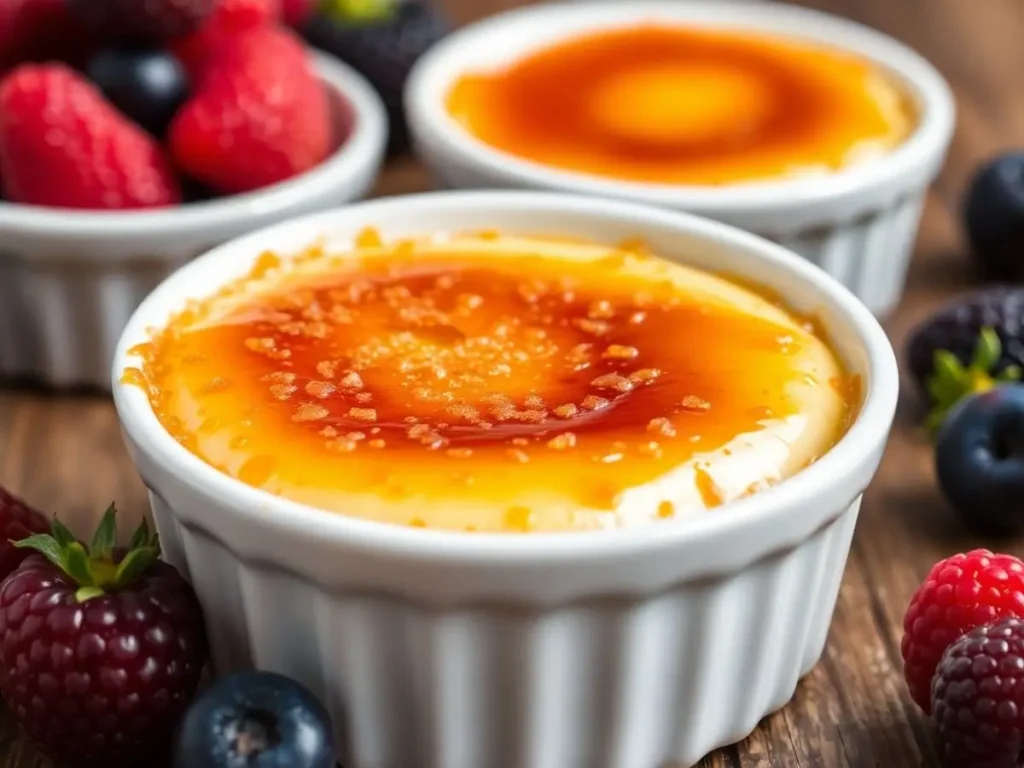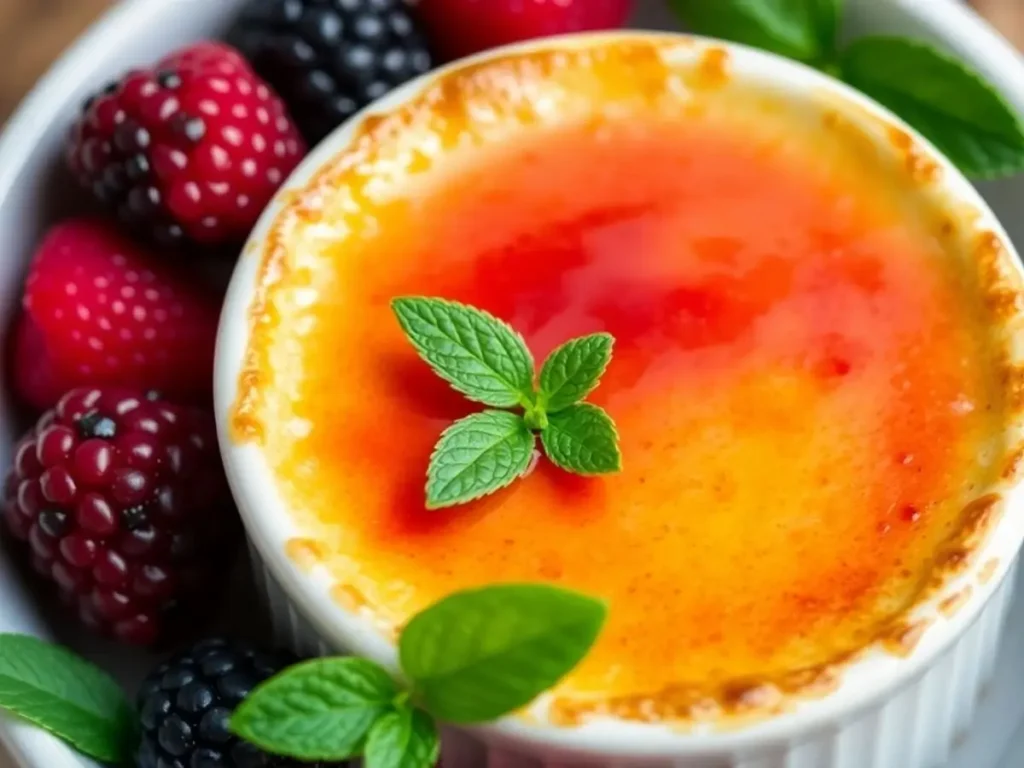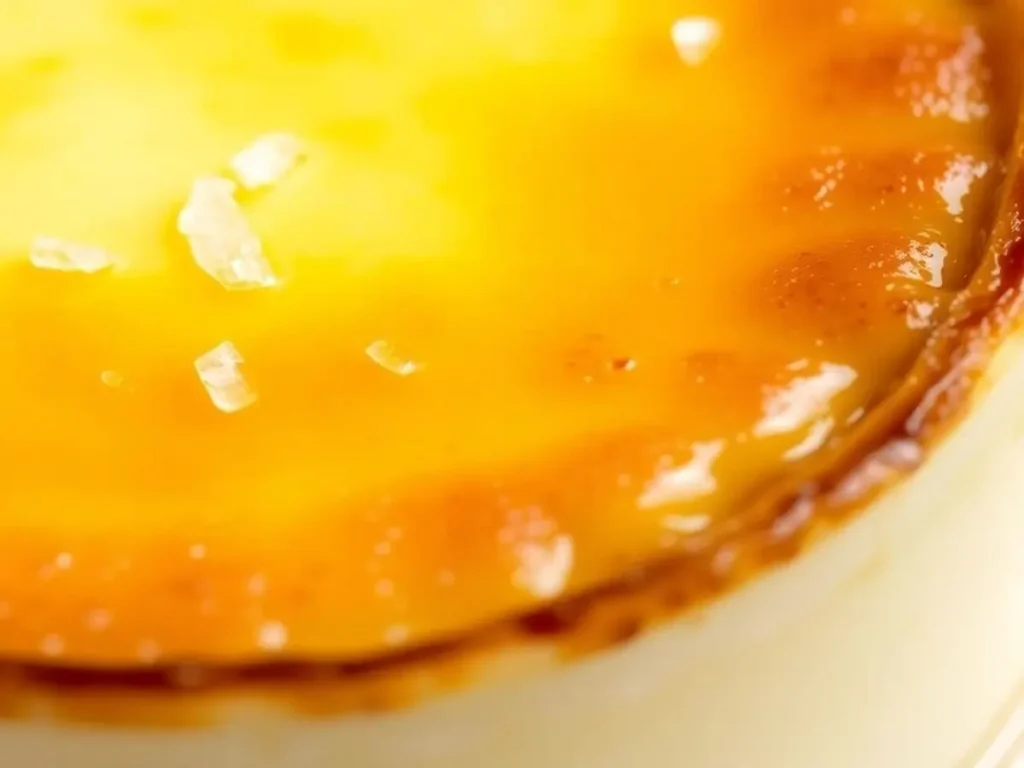So, you’re in the middle of whipping up some crème brûlée and realize you’re out of heavy cream. Bummer, right? But don’t worry, there are plenty of other ingredients you can use to make this classic dessert just as delicious. Whether you’re looking for a lighter option or need to go dairy-free, we’ve got you covered with some great alternatives. Let’s explore what you can use heavy cream in crème brûlée.
Table of contents
Key Takeaways
- Half-and-half can be a good lighter alternative to heavy cream, offering a similar texture.
- Whole milk might surprise you as a substitute, but it can work well for a less rich version.
- Coconut milk is a solid choice if you’re aiming for a dairy-free crème brûlée.
- Almond milk adds a nutty twist and can be a fun way to change up the flavor.
- Using a water bath is essential for achieving the right texture, no matter what substitute you use.
Exploring Dairy Alternatives for Crème Brûlée

Using Half-and-Half for a Lighter Texture
If you’re looking to cut down on the richness but still want a creamy texture, half-and-half is a great choice. It blends milk and cream, offering a balance that’s not too heavy but still rich enough to create a satisfying custard. When using half-and-half, you might notice a slight difference in texture it’s lighter and less dense than when using heavy cream. This makes it ideal for those who prefer a less indulgent dessert without sacrificing too much on taste.
Whole Milk: A Surprising Substitute
Whole milk can be a surprising yet effective substitute for heavy cream in crème brûlée. Although it contains significantly less fat, whole milk still provides a creamy base. However, expect the custard to be a bit lighter and more delicate. You may need to adjust your cooking time slightly, as whole milk can take a bit longer to set. This option is perfect for those who want to enjoy crème brûlée with a lower fat content.
Coconut Milk for a Dairy-Free Option
For a dairy-free alternative, coconut milk is your go-to. It offers a unique flavor twist with its subtle coconut taste, which pairs beautifully with the vanilla and caramelized sugar. Coconut milk has enough fat content to provide a creamy texture similar to heavy cream, making it an excellent substitute for those avoiding dairy. Just be prepared for a hint of coconut flavor in your custard, which can add an exciting dimension to this classic dessert.
Coconut milk is your go-to for a dairy-free alternative. Its creamy texture and subtle coconut flavor pair wonderfully with the caramelized sugar topping. For more indulgent recipes to complement your dessert, explore more delicious chicken wing dip variations to serve at your next gathering.
When substituting heavy cream in crème brûlée, consider the flavor and texture you desire. Each alternative brings its own unique qualities to the dish, allowing you to customize your dessert to fit dietary needs or flavor preferences.
Non-Dairy Options for Crème Brûlée

Almond Milk: A Nutty Twist
Almond milk is a fantastic choice for those looking to replace heavy cream in crème brûlée. Its subtle nutty flavor can add a unique twist to the classic dessert. When using almond milk, it’s important to choose an unsweetened version to maintain control over the sweetness of your custard. Almond milk has a lighter consistency, so you might notice a slightly different texture, but it still provides a creamy base for your dessert.
Soy Milk for a Creamy Consistency
Soy milk is another excellent non-dairy substitute that can mimic the creamy texture of traditional crème brûlée. It has a higher protein content compared to other plant-based milks, which helps in achieving a smooth custard. When selecting soy milk, opt for plain or vanilla-flavored versions to complement the dessert’s taste.
Oat Milk: The Vegan Choice
Oat milk has become a popular vegan alternative in many recipes, including crème brûlée. Thanks to its creamy consistency and mild flavor, it serves as a great substitute for heavy cream. One of its benefits is that it thickens naturally when heated, making it ideal for creating a rich and smooth custard. Additionally, oat milk has a slightly sweet undertone that complements the caramelized sugar topping beautifully. As a result, it’s a versatile and delicious choice for plant-based crème brûlée.
Exploring non-dairy alternatives for crème brûlée can be a delightful culinary adventure. Each option brings its own unique flavor and texture, allowing you to customize your dessert to fit your dietary preferences. Whether you choose almond, soy, or oat milk, you’ll be able to enjoy a delicious and satisfying crème brûlée without the heavy cream.
Enhancing Flavor with Unique Ingredients of Crème Brûlée

Infusing with Citrus Zest
Adding a hint of citrus zest can transform your crème brûlée into a refreshing delight. The zest from lemons or oranges brings a bright, tangy note that complements the rich custard. Use a fine grater to carefully zest your citrus, ensuring you avoid the bitter white pith. Sprinkle a bit into your custard mix before baking, and you’ll notice how the flavors pop.
Adding citrus zest or a touch of liqueur can elevate the flavor profile of your crème brûlée. While exploring creative twists for your dessert, learn the nutritional differences between calzones and pizza for another culinary deep dive.
Adding a Touch of Liqueur to Crème Brûlée
Incorporating liqueur into your crème brûlée is a simple way to introduce depth. Consider adding a splash of Grand Marnier or Amaretto for a sophisticated twist. These liqueurs blend seamlessly with the creamy texture, enhancing the overall taste without overpowering it. Just a tablespoon is enough to make a noticeable difference.
Spicing Up with Cinnamon
Cinnamon is a warm spice that pairs beautifully with the sweet, creamy nature of crème brûlée. A dash of ground cinnamon in the custard before baking can add a cozy, aromatic quality to the dessert. You can also sprinkle a bit on top of the caramelized sugar for an extra layer of flavor.
Experimenting with these ingredients can turn a classic crème brûlée into something extraordinary. Don’t be afraid to adjust the quantities to suit your taste, and enjoy the process of making this dessert your own.
Techniques for Perfecting Crème Brûlée Without Cream
Mastering the Water Bath Method
Creating a smooth and creamy custard without cream begins with the right cooking technique. To achieve this, a water bath is essential for ensuring even cooking and preventing the custard from cracking. Here’s how to do it:
- First, place your ramekins in a deep baking dish.
- Next, pour hot water into the dish, making sure it reaches halfway up the sides of the ramekins.
- Finally, carefully transfer the dish to the oven, ensuring the water doesn’t splash into the custard.
With this method, your custard will cook gently and evenly, resulting in a perfectly smooth texture.
Achieving the Perfect Caramelized Top of Crème Brûlée
The layer of sugar on top is iconic. To get that perfect caramelized finish:
- Sprinkle an even layer of sugar over the chilled custard.
- Use a kitchen torch to melt and caramelize the sugar. Move the torch in small circles to ensure even browning.
- If you don’t have a torch, you can place the ramekins under a broiler, but watch closely to avoid burning.
Balancing Sweetness and Texture
Without cream, balancing sweetness and texture becomes a bit tricky. Here are some tips:
- Use whole milk or a dairy-free alternative like coconut milk for a creamy texture.
- Adjust sugar levels to match the sweetness of your milk substitute.
- Consider adding a pinch of salt to enhance the flavors.
Experimenting with different milk alternatives can lead to delightful surprises. Don’t shy away from trying something new, as the perfect balance is often found through trial and error.
By focusing on these techniques, you’ll be able to create a crème brûlée that’s just as satisfying as the traditional version. Remember, practice makes perfect!
Tools and Tips for Making Crème Brûlée
Choosing the Right Ramekins
When making crème brûlée, ramekins are your best friend. They help you get that perfect, single-serving presentation. Aim for four to six 7-ounce ramekins. This size lets the custard bake evenly. If you’re feeling adventurous, you can try making one large crème brûlée in a baking dish, but smaller ramekins are generally more reliable.
Using a Kitchen Torch Effectively
A kitchen torch is essential for creating that signature caramelized sugar topping on crème brûlée. Without it, you won’t achieve the crisp, burnt sugar layer that makes this dessert so iconic. To use it, hold the ramekin in one hand and the torch in the other, moving the flame in small circles to evenly brown the sugar. However, if you don’t have a torch, a broiler can work as a substitute. That said, it doesn’t provide the same level of control or the perfectly crisp texture a torch delivers. For the best results, investing in a torch is worth it.
Storing and Serving Tips
Crème brûlée can be made a couple of days ahead. Just cover them with plastic wrap and pop them in the fridge. They’ll keep for up to four days. Remember, this dessert doesn’t freeze well it’ll turn into soup when thawed. Serve chilled, right from the fridge, for the best experience.
Making crème brûlée is all about balance. You need the right tools, like ramekins and a kitchen torch, to get that perfect texture and flavor. It’s a simple dessert, but the details make all the difference.
Common Mistakes to Avoid When Substituting Cream
Overcoming Texture Challenges
When you’re swapping out heavy whipping cream in your crème brûlée, texture can be a big hurdle. Heavy cream is what gives crème brûlée its rich, velvety feel. If you’re using something like milk or a non-dairy substitute, you might end up with a custard that’s too thin. To fix this, consider adding a bit of cornstarch or using egg yolks to help thicken the mixture. Also, keep an eye on cooking times; sometimes, substitutes require a little longer to set properly.
Preventing a Watery Custard
A watery custard is a common pitfall when you’re not using heavy cream. This often happens because the alternative doesn’t have enough fat content. Fat is crucial for that creamy consistency. To counter this, you can try using a blend of substitutes, like mixing whole milk with a bit of butter or choosing a thicker plant-based milk like coconut milk. Always strain your mixture before baking to catch any lumps or inconsistencies.
Avoiding Overpowering Flavors
When switching up the main ingredient, it’s important to avoid flavors that clash. For instance, some milk alternatives have strong, distinct tastes that can overpower the delicate vanilla notes of your crème brûlée. To keep the flavors balanced, opt for a substitute with a mild taste, such as almond or oat milk. Alternatively, ensure your flavorings are bold enough to shine through. For example, adding vanilla extract or a hint of citrus zest can help maintain the classic taste while preventing the substitute from dominating the dish. In this way, you can achieve a harmonious balance of flavors.
Remember, experimenting with substitutes is all about finding the right balance. Each ingredient brings its own character to the dish, so don’t be afraid to adjust and taste as you go.
Conclusion
So, there you have it! If you’re out of heavy cream but still craving that creamy, dreamy crème brûlée, don’t worry. There are plenty of substitutes that can still give you that rich texture and flavor. Whether you go for half-and-half, whole milk, or even coconut milk, each option brings its own twist to the classic dessert. Just remember, the key is to balance the flavors and textures to suit your taste. So go ahead, experiment a little, and enjoy your homemade crème brûlée adventure!
Frequently Asked Questions About Crème Brûlée
Can I use half-and-half instead of heavy cream?
Yes, half-and-half can be used as a substitute for heavy cream. It will give your crème brûlée a lighter texture while still maintaining its creamy flavor.
Is coconut milk a good substitute for heavy cream?
Coconut milk is a great dairy-free option. It adds a subtle coconut flavor to the custard, making it unique and tasty.
What non-dairy milk works best in crème brûlée?
Almond milk, soy milk, and oat milk are popular non-dairy choices. Each adds its own flavor twist, with almond milk being nutty, soy milk creamy, and oat milk smooth.
How do I avoid a watery custard?
To prevent a watery custard, make sure to cook it slowly and evenly, preferably using a water bath. This helps the custard set properly.
Can I add extra flavors to my crème brûlée?
Absolutely! You can infuse your custard with citrus zest, a splash of liqueur, or a sprinkle of cinnamon for added flavor.
What should I do if I don’t have a kitchen torch?
If you don’t have a kitchen torch, you can use your oven’s broiler to caramelize the sugar on top. Just keep a close eye to avoid burning.
